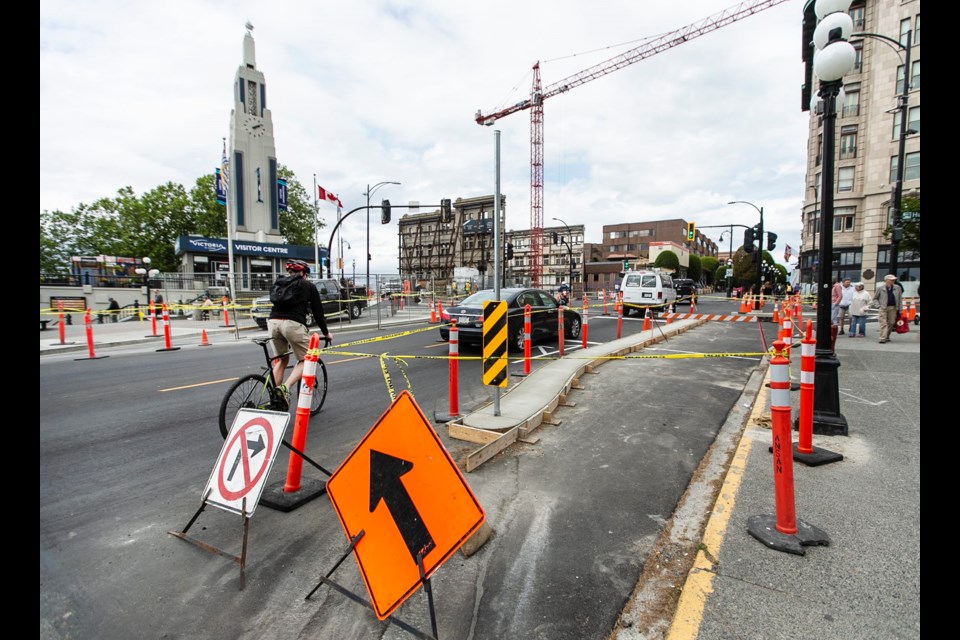 "If they make cycling any safer, somebody is going to get killed.” That was the assessment of my colleague, and cyclist, Jack Knox, as I whined to him about the plans to block off north/south access to cars on great swaths of Vancouver Street as part of the city’s All Ages and Abilities cycling network.
"If they make cycling any safer, somebody is going to get killed.” That was the assessment of my colleague, and cyclist, Jack Knox, as I whined to him about the plans to block off north/south access to cars on great swaths of Vancouver Street as part of the city’s All Ages and Abilities cycling network.
Let me make this clear, while I am not a cyclist, I am not opposed to bike lanes.
What I don’t understand, though, is why Victoria seems so intent on angering and alienating so many people — motorists, merchants and cyclists alike — with every leg of this bike network. It’s almost as if “must excel at pissing people off” is a hidden sub-text in every bike-lane contract.
Let’s not forget this is a project so reviled it had to be re-branded before the first phase was anywhere near completed. (Remember Biketoria anyone?) You’d think that after rebranding, you’d want to follow up by trying to get people on board.
But instead of trying to make it easier for cars and bikes to coexist, the city seems intent on trying to make life easier for cyclists by making life more difficult for motorists.
Let’s review.
After bringing in experts from as far away as Colombia and Copenhagen to identify the best routes, the city thought it was a good idea to introduce everyone to separated bike lanes by building a two-way separated bike lane on Pandora Avenue, a one-way street.
Building a two-way bike lane on a one-way street meant separate signalization for cyclists and motorists at intersections and elimination of right turns on red lights.
It must look good on paper, but near misses are still a daily occurrence as motorists used to making that right on red continue to do so despite the signals and signs.
There’s also the added bonus for cyclists of dodging the homeless who hang on Pandora Avenue near the Our Place street drop-in centre and regularly wander into the bike path without looking.
Oh yeah, the blind who now have to find their way across the bike lane to get to bus stops aren’t crazy about the design, either. The Canadian Federation of the Blind filed a complaint with the human rights tribunal and have called for its redesign.
Before anyone could catch their breath or even give the new Pandora bike lanes a try, the city started construction on the second leg, a two-way separated bike lane on Fort Street — again a one-way street, only this is one way in the opposite direction.
This time, merchants howled about the loss of parking so loudly that the city ultimately decided it was better to save spaces by cutting down trees. But construction ran longer than usual, pushing many merchants to the financial brink.
By the time the Fort Street lanes opened, transit drivers were complaining the project had squeezed sections of the roadway so much that someone parking too far from the curb could make it near impossible for them to pass.
Near misses are also a near daily occurrence on Fort as motorists and cyclists have separate signals for left turns at intersections — signals regularly not noticed by one of the players, a driver, pedestrian or cyclist.
The only outrage so far over the leg currently under construction — the two-way bike lane being squeezed onto Wharf Street — has been over the loss of a large birch tree at the intersection of Government and Humboldt. The loss of 21 parking stalls probably won’t be felt until tourist season is full on.
But it’s not open yet and this section has a lot of new wrinkles, so there are lots of adjustment ahead.
A simmering revolt on Cook Street where merchants worried planned bike lanes there would drive them out of business saw the city alter the route and shift the bike network to Vancouver (although they like to say the change was due to design consideration).
While plans for Vancouver call for construction of actual separated bike lanes on that section of road that runs downtown, the rest of the route is going to get a shared roadway treatment.
And I get the feeling a lot of people will feel blindsided once construction starts. I live a half a block away from Vancouver and never even got so much as a flyer in my mail box about the plan. I certainly don’t recall the city asking anyone: “Do you favour moving the proposed bike lanes off Cook Street if it means blocking through traffic on Vancouver Street?”
But that’s the plan. The idea is to reduce the number of cars using Vancouver from up to 6,200 a day to fewer than 1,000 — preferably about 500. This will be done by blocking off the road to cars in a couple of places by building plazas (there will be one at Pandora and one at McClure) and by restricting the turns cars can make.
Essentially, cars will be able to get to the apartments on and near Vancouver Street but won’t be able to use it to travel any distance north or south — the direction the road runs.
Victoria Mayor Lisa Helps loves the idea. It will be cheaper than trying to build separated lanes, she says, which also could mean the loss of trees.
It might be cheaper, but Vancouver Street is one of the few streets in the city that is wide enough to build bike lanes and keep all the parking. If city engineers can’t design bike lanes on Vancouver without threatening the trees, they need to go back to how-to-build stuff school.
As for the cost, one of the pitches that has been made for the bike lanes is that they are good value because they are primarily being funded from gas-tax grants.
Meanwhile, it’s hard to believe that adding 5,000 cars onto Cook or Quadra overnight won’t have major impacts.
And don’t forget, there are some on council who haven’t given up on the idea of eventually running more bike lanes down Cook.



